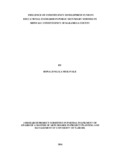| dc.description.abstract | The study sought to investigate the influence of Constituency Development Fund on provision of improved Secondary School education in Kenya while attempting to; assess the challenges encountered by secondary schools in accessing CDF funds; investigate the role of CDF on provision of facilities in secondary schools and establishing the role of CDF in improving enrolment in secondary. A theorized investment in secondary education (Oyaro, 2008) was seen to promote better qualified workforce, stronger economies and reduced poverty. The study used descriptive research design that included 10 head teachers, 1 officers in the District Education Office, 50 teachers and 60 students from 10 public secondary schools that included Mukhonje mixed secondary, St Agnes Girls‟ High school, Friends school Mugomari mixed secondary, Shidodo mixed secondary, St. Ignatius Mukumu Boys, Bukhaywa secondary, Lwanda secondary, St. Gerald Shanjero, St Joseph Malimili secondary and Shanderema Boys secondary school. Trial testing of the measuring instruments was undertaken using a few subjects whose characteristics are similar to those in the sample to ascertain the feasibility of the study Quantitative data were collected using structured questionnaires, analyzed using the Statistical Package for Social Scientists (SPSS ver. 20) where a Codebook for the various quantitative variables was prepared. The Codebook was prepared based on the numbering system of the questionnaires (all the questionnaires were numbered before data collection for ease of referencing). After verifying that all data entered is correct, data analysis using the various SPSS tools were then be conducted and frequency tables, cross-tabulations (with chi-square) and regression studies summarized the significant levels of association as measured against the alpha value, 0.05. The instruments of data collection were questionnaires and interview schedules. Reliability was ensured through the test retest method. A joint frequency distribution of cases within variables and their relations in category shall be used in combination with chi-square as an indicator of association. It aimed at establishing relationships among two or more of the variables owing to the fact that categorical variables often had such small numbers of possible values that could not be assumed in the study. Descriptive methods were employed in data analysis where frequencies and cross tabulations with chi were used in presenting the respondents‟ perception of issues raised in the questionnaires so as to answer the research questions. The study found out that success of CDF was being undermined by inadequate amount awarded, discrimination and mismanagement of funds and hence the amount awarded should be increased and cases of discrimination and corruption should be curbed. It is hoped that the findings of this study will contribute to the understanding of the role of the CDF in addressing the issue of provision of secondary school education in constituency. Further the study recommends enactment of stricter provision in the CDF act that will exempt politics from management of CDF funds and further outline what the nation terms as need. i.e. a need assessment should be conducted thoroughly and term need where it should be termed. In this effort, beneficiaries of the fund shall be outlined and thus avoiding political interference that leads to misappropriation of the funds in most situations | en_US |

